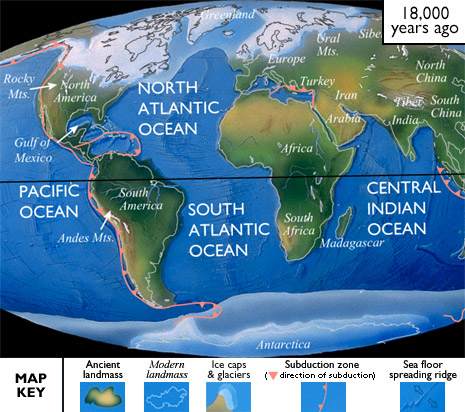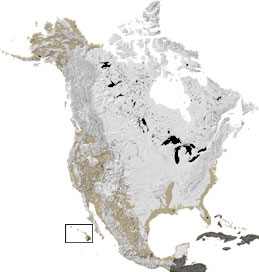the Quaternary - 1.8 Million Years Ago to Present
|
|
|
World Paleogeography: Throughout the Quaternary, most of the continents have followed the same movements they began in the Late Tertiary. India and Australia have continued their movement north, adding to the Himalayas in Asia and the volcanic islands and eruptions in the South Pacific. Africa and Europe have continued drifting farther from North and South America, widening the Atlantic Ocean. Subduction of several plates beneath North America’s western margin has nearly finished, and now most of North America is moving southeast relative to the Pacific Ocean. Relatively cold climates have prevailed on the earth for the past five million years, but the major glaciations of the Pleistocene Ice Ages began roughly 1.8 million years ago. During these glacial periods (only one of several episodes of glaciation in Earth's history), ice sheets extended from their present positions on Antarctica, the Arctic Ocean, and Greenland over much of North America, Europe, Asia, and South America. North American Paleogeography: In North America, glaciers swept down across Canada several times during the Quaternary, extending south into the U.S. as far as present-day Kansas. As the glaciers moved south, they picked up sediment, gouging out features like the Great Lakes and Finger Lakes, and dropped it in different places, forming features like Long Island, Cape Cod, and many of the hills from Pennsylvania to South Dakota. Paleontology: The Quaternary has also seen the evolution and expansion of our own species, Homo sapiens. Quaternary fossils are often abundant, well preserved, and can be dated very precisely. Many paleontologists study Quaternary fossils, such as diatoms, foraminifera, and plant pollen in order to understand the climates of the past. The time since the melting of the last major ice sheet (about 11,000 years ago) is known as the Holocene, or Recent. |
|
 |
See the Quaternary in:
Or jump to another period:
|
|
Links to more about the Quaternary
|
Organizations | Education and Exhibits | Research and Collections | Resources
Organizations
Parks (showing 2 of 2 listings)
Mastodon State Historic Site: This site provides information about the programs and exhibits offered, including the Kimmswick Bone Beds that have produced many mastodon bones.
Big Bone Lick State Park, Union, Kentucky: Called "The Birthplace of American Vertebrate Paleontology", the fossilized remains of past inhabitants of Big Bone Lick State Park provide clues about ancient life in Kentucky. This park features a discovery trail and outdoor museum with varied grassland, wetland and savanna environments.
 Top of List Top of List
Societies and Clubs (showing 2 of 2 listings)
North Dakota Geological Survey Fossil Resource Program: Links to all varieties of information on North Dakota paleontology, including research papers, museums, and background information on the state's fossils.
The American Quaternary Association: The American Quaternary Association (AMQUA) is a professional organization of North American scientists devoted to studying all aspects of the Quaternary Period, about the last 2 million years of Earth history.
 Top of List Top of List
Colleges and Universities (showing 1 of 1 listings)
Northern Arizona State's MS degree in Environmental Sciences & Policy with an emphasis in Paleoenvironmental Sciences: Paleoenvironmental scientists investigate the recent geological past to learn about natural and human-caused environmental and climatic changes. In this interdisciplinary curricular track, you’ll develop broad competence in earth and environmental sciences, while specializing in an analytical technique used to reconstruct long-term environmental variability.
 Top of List Top of List
Museums (showing 3 of 15 listings)
George C. Page Museum: Explore a virtual exhibit about the Tar Pits, learn about the animals and environments of California during the Quaternary, and find information on when, where, and how to visit the La Brea Tar Pits.
The Mammoth Site: This site provides information about the site itself, the world's largest mammoth research facility, and provides a virtual tour and information on the geology of the site.
University of Alaska Museum of the North--Arctic Dinosaurs and More: This is the principal natural history museum of Alaska and the Arctic. It features collections & exhibits of Arctic dinosaurs, Quaternary mammals, including unequaled mummified remains,Teriary and Mesozoic collections of mollusks. 
 More Museums More Museums
 Top of List Top of List
Government Agencies (showing 2 of 2 listings)
Delaware Geological Survey: This Geological Survey site has pages on the fossils, and dinosaurs, of Delaware.
Dr. John D. Cooper Archaeological and Paleontological Center: The Dr. John D. Cooper Archaeological and Paleontological Center is dedicated to preserving the natural and cultural history of Orange County, California. The Cooper Center, a partnership between O.C. Parks and California State University Fullerton, is committed to the preservation, curation, and management of the fossils and artifacts collected within the County.
 Top of List Top of List
Education and Exhibits
Virtual Exhibits (showing 3 of 12 listings)
Ancient Denvers: Ancient Denvers is a virtual exhibit that highlights 13 reconstructions of ancient Colorado landscapes.
Ice Age Online: Ice Age Online, originally developed to accompany a temporary exhibit at the Denver Museum of Nature & Science, offers a wealth of information on the Pleistocene ice age, including profiles of ice-age vertebrates, and a discussion of how we know that the ice age occurred.
Pipe Creek Sinkhole: Information about a locality in Grant County, Indiana—an ancient sinkhole containing Pliocene and Pleistocene fossils.
 More Virtual Exhibits More Virtual Exhibits
 Top of List Top of List
Physical Exhibits (showing 3 of 3 listings)
The Pleistocene Nevada Exhibit: The Nevada State Museum in Carson City maintains an exhibit on the Pleistocene in Nevada including a look at the paleoecology of that time.
Hall of Florida Fossils: Evolution of Life and Land: Drawing upon the museum's internationally acclaimed fossil collections, this exhibit encapsulates the last 65 million years of Earth's history.
Cincinnati Museum Center at Union Terminal: Museum of Natural History and Science: A description of the exhibits available at the museum, for example a look at Cincinnati's Ice Age: Clues Frozen in Time. Also includes contacts for natural history collections and other general information.
 Top of List Top of List
Research and Collections
Ongoing Research Projects (showing 3 of 9 listings)
Sam Noble Oklahoma Museum of Natural History: On the campus of the University of Oklahoma in Norman. One of the finest university-based museums in the nation, with an active Paleontology research program and extensive collections. 
Database of the Former British Petroleum Microfossil Collection at the NHM, London: In 1991 BP donated to The Natural History Museum their Micropalaeontological Collection. This collection has an extensive geographical and stratigraphic coverage and is a record of BP’s exploration activity since the 1950s. The database hold details of material from over 3,500 individual well runs. The collection includes micropalaeontological assemblage slides and residues; palynological slides and residues and nannofossil slides from wells and outcrop from over 120 countries world-wide.
The Former Aberystwyth Microfossil Collection: This on-line catalogue is designed for university academics and industrial micropalaeontologists who are interested in post Palaeozoic ostracods and foraminifera. Searching this database gives broad information about discrete collections within the Former Aberystwyth University Micropalaeontology Collection that is now housed at the NHM.
 More Ongoing Research Projects More Ongoing Research Projects
 Top of List Top of List
Researchers (showing 3 of 3 listings)
University of Iowa Paleontology Repository: The UI Paleontology Repository is home to over a million fossils from all over the world and from all time periods, and is used for research and teaching. We also provide education services, hands-on tours around the collections and geology exhibits for schools and community groups, and fossil identification and collection care services.
Paleobotany and Palynology at the Florida Museum of Natural History: The Paleobotany and Palynology Collection at the Florida Museum of Natural History is international in scope, including collections from 47 countries. Systematically the greatest strength of the collection is in Cretaceous-Tertiary angiosperms.
Laboratory for Environmental Biology, Centennial Museum: Home page for the LEB at University of Texas at El Paso, with information on collections and research.
 Top of List Top of List
Resources
Maps (showing 2 of 2 listings)
Illinois State Geological Survey, Quaternary Deposits Map: Map showing the extent of the Quaternary glacial deposits covering Illinois.
Paleogeography and Geologic Evolution of North America: The images presented here show the paleogeography of North America over the last 550 million years of geologic history.
 Top of List Top of List
Databases (showing 3 of 5 listings)
UF Vertebrate Paleontology Databases: On-line, searchable databases of over 200,000 specimens in the collection of the Florida Museum of Natural History, Gainesville.
New Mexico Museum of Natural History and Science Web-based Paleo-database Home Page: Search the fossil collections of the New Mexico Museum of Natural History and Science. Listings by Kingdom down to species, era, epoch, group, formation, country, New Mexico county, and map ID. Many listings contain images of the fossils (including all holotypes.) 
Neogene Marine Biota of Tropical America: NMITA is an online biotic database containing images and data for taxa used in analyses of Tropical American Biodiversity over the past 25 million years. NMITA is designed for use in research and education in systematics and evolutionary paleontology. Major fossil groups included are bryozoans, corals, molluscs, ostracodes, and fish. Users may browse or search images and information about taxa or click on maps and stratigraphic columns for faunal lists for specific horizons. NMITA also provides several educational activities. 
 More Databases More Databases
 Top of List Top of List
Image Collections (showing 2 of 2 listings)
Some Fossil Brachiopods: Images of several fossil brachiopods, dating in geologic age from early Cambrian to Pleistocene, with explanatory text.
Levin Fossil Collection: An image gallery of an amateur collector's finds, focusing on fossils of all ages from Kansas.
 Top of List Top of List
Field Guides (showing 3 of 3 listings)
The Pleistocene Fauna of South Texas: An annotated fossil list, with photographs of specimens, of late Pleistocene fossils from South Texas.
Champlain Sea Fossils: A 1994 site on marine fossils from the Champlain Sea, an epicontinental ephemeral sea which filled most of the Ottawa-St.Lawrence-Lake Champlain basin at the end of the last continental glaciation (8000-11000 years ago).
Fossils From Pleistocene Lake Manix, California: The fossiliferous Upper Pleistocene Manix Formation on California's Mojave Desert; many images of fossils; detailed virtual field trips, plus many pertinent links.
 Top of List Top of List
General Reference (showing 3 of 6 listings)
Utah’s Wildlife in the Ice Age: This site, from the Utah Geological Survey, features a summary of northern Utah fossils, giving us a deeper understanding of wildlife that came before us.
Quaternary Geology of the Yukon Territory: A pdf describing the Quaternary geology of the Yukon Territory.
Fossils In Death Valley National Park: The paleontology, geology and natural wonders of Death Valley National Park (and more); many images of fossils; field trips; paleontology links, plus links to Death Valley.
 More General Reference More General Reference
 Top of List Top of List
|
|



